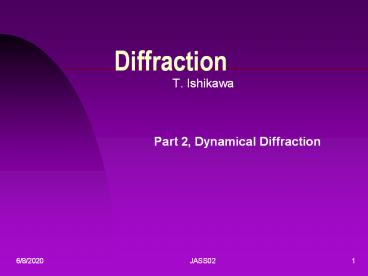Diffraction - PowerPoint PPT Presentation
Title:
Diffraction
Description:
Bloch Theorem. Waves inside Periodic Medium. u(r) has periodicity of crystal lattice ... Bloch Wave b. large absorption. Anomalous Transmission (Borrman Effect) ... – PowerPoint PPT presentation
Number of Views:74
Avg rating:3.0/5.0
Title: Diffraction
1
Diffraction
- T. Ishikawa
Part 2, Dynamical Diffraction
2
Introduction
- In the 1st part, we dealt with Kinematical
Theory where the scattered x-rays suffer no
additional scattering. - The 2nd part is designed to give basic ideas of
Dynamical Diffraction observed with perfect
crystals as a result of multiple scattering.
3
Basic Idea
Kinematical Diffraction
Dynamical Diffraction
4
Maxwell Equation (1/2)
E electric fieldD electric displacementH
magnetic fieldB magnetic inductionr charge
densityj current densityP polarizationM
magnetizatione0 permittivity of vacuumm0
permeability of vacuumc electric
susceptibilityc speed of light in vacuum
5
Maxwell Equation (2/2)
For periodically oscillating electromagnetic
field jtrue 0, rtrue 0. For non-magnetic
materials, M0 so that B m0H.
6
Polarization
- Polarization P electric dipole moment in unit
volume
c(r) have the periodicity of crystal lattice
7
Electromagnetic Wave in Periodic Medium
Bloch Theorem
Incident Plane Wave in Vacuum
Waves inside Periodic Medium
u(r) has periodicity of crystal lattice
u(r) can be expanded in a Fourier Series with
reciprocal lattice vector, g.
Bloch Wave
8
Some Mathematic....
9
Mathematics (contd)
()
10
Basic Equations for Dynamical Theory
Condition for the equation () should be valid
for arbitrary r gives the basic equation for
dynamical diffraction theory
Since
the basic equation is well approximated by
11
Boundary Conditions (1/3)
z
Fields in vacuum (Ea, Da) Fields in crystal
(E, D)
vacuum
zH
Boundary conditions from Maxwell
Equations Continuity of tangential components of
Electric Fields Et Eat Continuity of normal
components of Electric Displacements Dz Daz t
tangential component, z z(normal) component
crystal
12
Boundary Conditions (2/3)
Wavefield Superposition of plane waves
Wave Vector in Crystal KgWave Vector in Vacuum
Km
Kgt Kmt
Km
crystal wave
Kg
vacuum wave
13
Boundary Conditions (3/3)
Boundary Condition at zH (Crystal Surface)
14
Two-Wave Approximation (1/3)
Under usual experimental conditions, only two
waves with K0 (incident direction) and Kg
(diffracted direction) are strong inside the
crystal.
Wavefield in crystal
Basic Equation
Averaged refractive index of crystal
Polarization Factor
15
Two-Wave Approximation (2/3)
Condition for the basic equation,
dispersion surface
to have non-trivial solutions is
Ko
Kg
g
By introducing new parameters
16
Two Wave Approximation (3/3)
y
For non-absorbing crystals,
Tg
Lo
x
When we introduce a new parameter L as
To
,
Near the point Lo,
Dispersion surfaces formHyperbolla
17
Amplitude Ratio
Amplitude Ratio
j 1, 2
18
Diffraction Geometry
Symmetric Laue Case
Symmetric Bragg Case
19
Symmetric Laue Case
Dispersion sphere of vacuum wave (radius
K) Starting point of wave vector Ko P Laue
point L Deviation from Bragg Condition
20
Symmetric Laue Case Deviation Parameter
Deviation Parameter W
Solving above equations, we can get
upper sign j1, lower sign j2
Usually WWs
21
Symmetric Laue Case Amplitude Ratio
Here,
For non-absorbing crystals,
22
Symmetric Bragg Case (1/2)
Between L1 and L2, z has no intersections with
dispersion surfaces.
Total Reflection Region
Deviation from Bragg Condition
23
Symmetric Bragg Case (2/2)
Dqo Deviation from geometrical Bragg angle by
refraction
upper sign j1, lower sign j2
Deviation parameter, W
Amplitude Ratio
upper sign j1, lower sign j2
24
Rocking Curves
Use monochromatic plane wave as an incident
beam Rocking the sample crystal around the Bragg
angle
We can observe so-called rocking curve.
25
Rocking Curve Symmetric Laue Case (1/3)
Incident Wave
Ka,Eoa
Crystal Wave
z0
o-wave
Kg2, Eg2
Ko2, E02
g-wave
zH
Ko1, Eo1
Kg1, Eg1
Outgoing Wave
Ka,Eda
Kga,Ega
o-wave
g-wave
26
Rocking Curve Symmetric Laue Case (2/3)
Boundary condition at z H (exit surface)
Boundary condition at z 0 (incident surface)
upper sign j1, lower sign j2
At W0 (exact Bragg condition),
27
Rocking Curve Symmetric Laue Case (3/3)
28
Rocking Curve Symmetric Bragg Case (1/3)
Boundary condition at z 0
Ka,Eoa
Kga,Ega
z 0
Kg1, Eg1 Wlt-1
Ko1, Eo1 Wlt-1
upper sign Wlt-1, lower sign Wgt1
Kg2, Eg2 Wgt1
Ko2, Eo2 Wgt1
29
Rocking Curve Symmetric Bragg Case (2/3)
Another solution will give a divergent solution
30
Rocking Curve Symmetric Bragg Case (3/3)
Rocking curve (Darwin Curve)
Wlt1 All incident energies are reflected
back. Total Reflection
Center of total reflectiuon, W0, is deviated
from geometrical Bragg angle qB by
Range of total reflection (-1ltWlt1)
Darwin Width, microradian order
31
Absorbing Crystal
Absorption Anomalous dispersion term into
atomic scattering factor
Centrosymmetric Crsyatls
A new parameter k is defined as
32
Symmetric Laue Case Absorbing Crystal (1/2)
Oscillating Term, Hardly to be observed
experimentally without very good plane wave
averaging
Anomalous Transmission (Borrman Effect)
33
Symmetric Laue Case Absorbing Crystal (2/2)
Forward Diffraction
Thin Crystal
Thick Crystal
34
Symmetric Bragg Case Absorbing Crystal
Rocking curve for a symmetric Bragg case
diffraction from a semi-infinite absorbing
crystal(with centrosymmetry)
k 0
k 0.1
35
Summary
- Very quick scan of x-ray diffraction theory was
attempted. - You may need reference text books.
- References
- Dynamical Theory of X-Ray Diffraction,A. Authie,
Oxford University Press, 2001 - Handbook on Synchrotron Radiation Vol. 3,
North-Holland, 1991.
36
Thank you for your attention.
Acknowledgement Some materials presented here are
originally prepared by Prof. Seishi Kikuta for
his textbook written in Japanese. Some ppt
materials have been prepared by Dr. Shunji Goto.
Discussion in preparing the lecture with Drs.
Shunji Goto, Kenji Tamasaku and Makina Yabashi is
appreciated.































